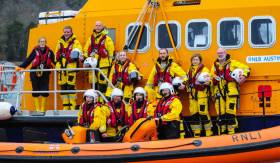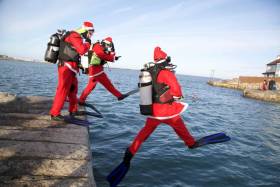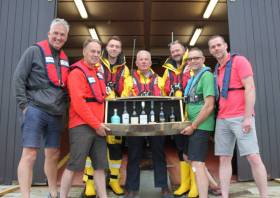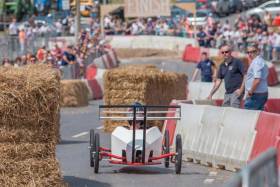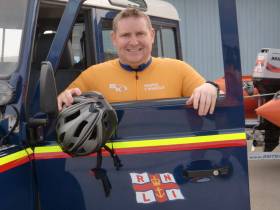Displaying items by tag: Fundraising
Cork Lifeboat Crews To Share Their Lifesaving Stories This Wednesday On RTÉ’s Nationwide
Volunteer lifeboat crews from Crosshaven and Ballycotton RNLI in Cork will share their own stories of how they got involved with the lifesaving charity on TV for RTÉ One’s Nationwide this coming Wednesday 18 December.
And the two stations will also carry out a joint exercise to recover an unconscious casualty from the water, as they appeal to the public to support the RNLI’s ‘Perfect Storm’ fundraising campaign.
In Crosshaven, local business owners Aoife Dinan, of Rejuvenate beauty salon, and Denis Cronin of the popular Cronin’s Bar both volunteer for the Cork Harbour village’s lifeboat crew.
Denis was a keen surfer before he volunteered for the lifeboat and now answers the pager by jumping on his pushbike and heading to the station a couple of minutes away.
Aoife and her partner lost a close friend to drowning and she is now an active member of the lifeboat crew, often running from her business to make callouts at the station.
Best friends Molly Murphy and Caoimhe Foster joined the lifeboat together when they were in fifth year in school. They speak about what it was like to rush out of the classroom and down to the lifeboat station for a callout and to leave their schoolmates behind.
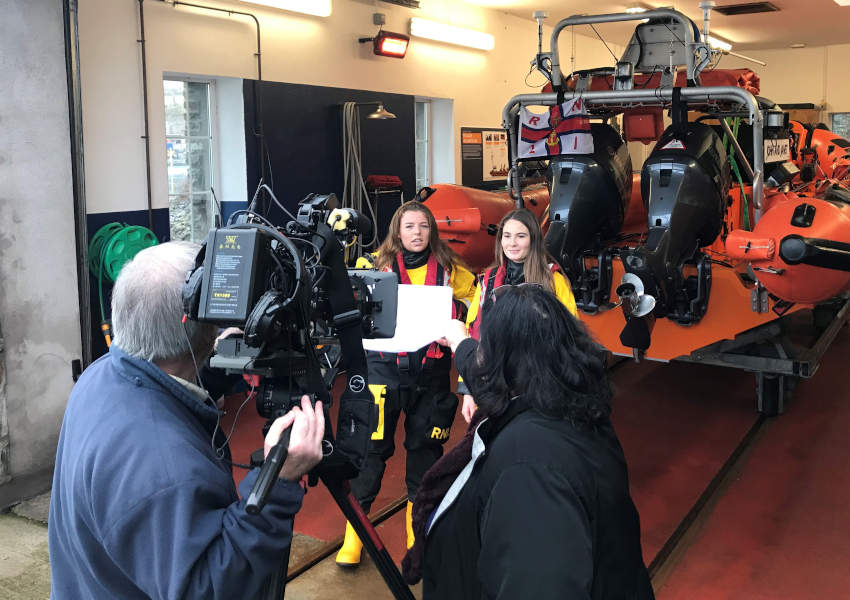 Crosshaven RNLI volunteers and best friends Molly and Caoimhe face the RTÉ Nationwide camera | Photo: RNLI/Niamh Stephenson
Crosshaven RNLI volunteers and best friends Molly and Caoimhe face the RTÉ Nationwide camera | Photo: RNLI/Niamh Stephenson
Ballycotton RNLI crew member Alan Cott lost his brother Glynn when the Maggie B sank in 2006. He is very proud of his involvement with the lifeboat and is honouring the memory of his brother in the work he does to save lives at sea.
Speaking about the programme and the launch of the Perfect Storm appeal by the RNLI, area lifesaving manager Brian O’Driscoll said: “Our lifeboat crew are what is best in the RNLI. These men and women give up their time to train and launch lifeboats in all weathers and to all types of situations.
“Our thanks to the Nationwide team for visiting two of our Cork lifeboat stations and speaking to our volunteer lifeboat crew about why they do it and what they get out of it.
“Many people don’t realise that the RNLI is a charity and we depend on the generosity of the public to continue with our work saving lives at sea.
“Aoife, Denis, Alan, Molly and Caoimhe give their time and their passion to the RNLI and in return they get the training, skills and equipment to be able to help those in trouble at sea. We are very grateful for the support of the public and we don’t take it for granted.”
To support the RNLI’s Perfect Storm appeal this Christmas, helping to ensure the charity’s brave volunteers can continue saving lives at sea, visit RNLI.org/ThePerfectStorm
Santa Scuba Dive Takes The Plunge For Lifeboats In Sandycove This Weekend
Tomorrow at noon (Sunday 15 December) Scuba divers dressed in Santa suits will be ready to dive into the sea water off Sandycove for the annual Santa Scuba Dive.
This unique Christmas event has raised over €12,000 for the RNLI since it was started in 2014 by Karen Kenny of the Dublin University Sub Aqua Club.
Divers will enter the water at 1pm, and spectators will also see the local D-class lifeboat and Howth Coast Guard RIB and a flyby from the Dublin-based coastguard helicopter, weather and operations permitting.
For more see the event page on Facebook and the fundraising page on JustGiving.
Sailors Do A ‘Whiskey Run’ For Portrush & Islay Lifeboats
A group of seven men from the North Coast hatched a novel way to carry out some fundraising for the Portrush and Islay RNLI volunteer lifeboat crews recently.
As a group of keen sailors and avid supporters of the RNLI and the Scottish islands, they wanted to marry the two passions together and have some fun along the way.
The team decided to row to Islay to recreate a journey made over the generations using only manpower to raise money for the lifeboats.
The team was fortunate to be able to borrow ‘Home to Portrush’, the famous local boat that had crossed the Atlantic in record time in February 2018. Their challenge was to visit all the coastal distilleries on Islay and collect some whiskey from each one.
Ashley Moore, one of the crew, said: “We left from Ballintoy at 3am in idyllic conditions in order to reach Port Ellen and not be swept around the headland as the tide turned.
“Thankfully we made it in nine-and-a-half hours and over the next three days went on to visit Laphroaig, Lagavulin, Ardbeg, Coal Ila, Bunnahabhain, Bowmore and Bruichladdich, collecting whisky bottles along the way.
“We were blown away by the warmth of the welcome across Islay and the distilleries — we were given many offers of food and accommodation and each distillery presented us with a bottle of whisky and a stave from one of their barrels to allow us to create the Islay Sea Collection.”
On returning home, team member and local architect Graeme Montgomery set out to design and create a unique cask to display the bottles of whisky, with the source of each stave marked.
‘This is a really exciting and novel way to raise funds for the two stations’
Bids are now being accepted until Sunday 17 November at just-whisky.co.uk for this ‘one of a kind’ whisky collection — and sponsors, including Coleraine software company Spatialest, have already pledged £2,000.
To register to bid you will have to pay £5 but this will be donated to RNLI. During registration, under box number 2 will see a box asking you to leave a message — in this box you must type in RNLI BID to ensure that the £5 registration fee comes to Portrush and Islay RNLI.
Portrush lifeboat operations manager Keith Gilmore said: “This is a really exciting and novel way to raise funds for the two stations. We often have to work with Islay, and this is a great way to work with one of our neighbours and local supporters to raise funds for the RNLI.”
Ashley Moore added: “This was a really fun way to see the Scottish islands in a different way while helping to raise funds to support the work of the RNLI – and to enjoy some exceptional whisky!
“As sea lovers each one of our team never takes for granted the exceptional and brave work of the lifeboat crews and we are so grateful to know they are there whenever needed.”
Hero’s Welcome In Ballycotton For Eoghan Quinn Despite Lack Of Wind Foiling His Kitesurf Challenge
There was some disappointment for kitesurfer Eoghan Quinn as his attempt to ride the waves from France to Ireland yesterday (Sunday 30 June) ended prematurely when the wind dropped off Cornwall, just short of the halfway point.
But the 31-year-old, who has Type 1 diabetes and was taking on the challenge to raise funds for and awareness of Diabetes Ireland, arrived in Ballycotton on his support boat yesterday evening to a hero’s welcome.
“A lot of planning went into this but mother nature is the one thing we cannot control, but we achieved what we set out to do which was to raise awareness,” he told RTÉ News.
The route from France to Ireland through the Celtic Sea — dubbed the ‘Kitesurf Road’ — has never before been completed by kite and board.
Quinn had hoped to beat the Cherbourg-Rosslare ferry by crossing in under 16 hours.
Ballycotton welcomes @EoghanQuinn1 pic.twitter.com/lwoL2KWw9U
— Ballycotton (@BallycottonIRE) June 30, 2019
A Waterford man with Type 1 diabetes is currently kitesurfing over 275 miles of open water from France to Ireland today (Sunday 30 June) in aid of a charity supporting people with the disease.
Eoghan Quinn is attempting to race the Cherbourg-Rosslare ferry and cross the waves of the Celtic Sea in under 16 hours to raise funds for of Diabetes Ireland. (See his EverydayHero fundraising page HERE.)
It’s a route that’s never before been completed by a kitesurfer — and Eoghan will have the added complication of managing his blood glucose and insulin levels along the way.
But such challenges are nothing new to the 31-year-old kitesurfing champion, who has previously completed a 6,000km cycle to Gaza and a 1,000km ride from Melbourne to Sydney.
Diabetes Ireland has more on the story, and you can track Eoghan’s progress HERE.
Guy O’Leary’s challenge to swim a mile each day during the month of May has so far raised a whopping €70,000 for Cancer Research UK.
As previously reported on Afloat.ie, Guy — son of Dun Laoghaire Marina developer and local sailing stalwart Michael O’Leary — was diagnosed with cancer after a routine check-up in November 2017 at the age of 34.
Following a lengthy period of treatment, he decided he needed to do something to pay back the medical staff and researchers — not to mention family and friends — whose support means he’s still here today.
That’s where his idea to swim a mile a day in the month of May came about.
Guy began his MileADayInMay! challenge on Wednesday 1 May with his wife Aoife, and as he continued was joined each day by “someone who helped me through the rough times”.
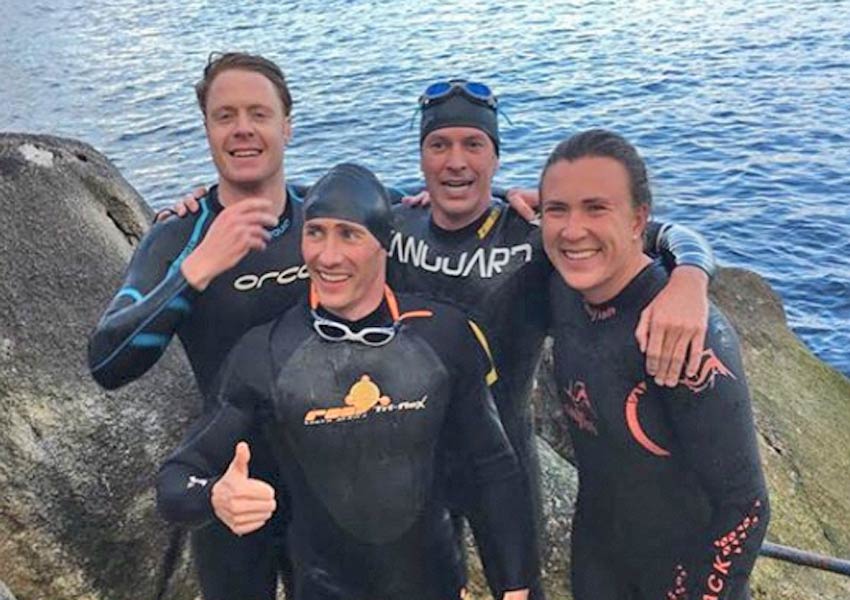 Guy (left) with Annalise Murphy and friends on Day 27 of his challenge | Guy O’Leary/Instagram
Guy (left) with Annalise Murphy and friends on Day 27 of his challenge | Guy O’Leary/Instagram
These included names familiar to Afloat.ie readers such as Annalise Murphy, the Goodbodys and Kinsale’s Sam Hunt — as well as others with a closer connection to the reason for his challenge such as fellow cancer patient Jim Right Now, and his own oncology nurse Lorna Lee.
Over the month he and his swimming companions braved the chilly waters of Killiney Bay, the more comfortable environs of the Trinity College pool, and even sunny Brockwell Lido and the Olympic pool in London.
And as promised, his final mile started outside Dun Laoghaire Harbour, finishing at the Royal Irish Yacht Club slipway.
“This has been an incredible challenge for me,” he said after his last swim of the month. “Thanks to the 45 swimmers who completed a mile with me and for all the donations so far.”
As of today the total raised stands at are than £62,000 — and Guy’s fundraising campaign is still active for anyone who wants to contribute.
Bundoran Lifeboat Crew Gears Up For Soapbox Sunday
Final preparations are being made ahead of this weekend’s Bundoran RNLI Soapbox Race which takes place this Sunday 2 June at Astoria Road.
Now in its eighth year, the event is organised and hosted by the volunteer crew of the Bundoran RNLI lifeboat and is a major fundraiser for the charity.
The event is expected to attract as many as 2,000 soapbox enthusiasts and their supporters with race winning between 1pm and 4pm, weather permitting.
The prize up for grabs is the highly coveted Perpetual Cup and 12 months of bragging rights.
And the ever-popular €1,000 ball race will also take place directly after the soapbox final has been run, with balls on sale at just €5 from lunchtime on the day.
Event director Cormac McGurren says that the crew is looking forward to the day.
“The soapbox race is always the talk of the station for the weeks and months before it happens. It’s a fun family day out with lots of thrills and spills expected.
“We would like to thank in advance all of our sponsors, prize donors and local volunteers who are helping to run the event and also to sell the balls.”
Those wishing to race a soapbox on the day are encouraged to register online, though last-minute registrations on the day will be accepted.
There will be a number of traffic restrictions in place this Sunday to facilitate the race. Astoria Road will be closed from 8am till 7pm on Sunday at the junction with Main Street.
Traffic for Waterworld, Bundoran Adventure Park and Ozanam House should use Promenade Road and Atlantic Way. Traffic for Main Beach, Great Northern Hotel and Bundoran Golf Club should use Sea Road. Main beach car park will be open for parking as normal (with access via Sea Road).
Guy O’Leary Is Swimming A Mile A Day In May For Cancer Research
Guy O’Leary is back on his feet after more than a year of cancer treatment — and to prove it he’s challenged himself to swim a mile each day during the month of May.
Beginning this Wednesday 1 May, each day of the MileADayInMay! swimming challenge will see Guy joined by “someone who helped me through the rough times” to raise funds for Cancer Research UK.
And Guy’s final swim of the month will start outside Dun Laoghaire Harbour, finishing at the Royal Irish Yacht Club slipway.
Guy — son of Dun Laoghaire Marina developer and local sailing stalwart Michael O’Leary — was diagnosed with cancer after a routine check-up in November 2017 at the age of 34.
“My incredible surgeon performed a bowel resection straight away but a subsequent PET scan revealed the disease had spread to my liver,” he says.
“Another major operation, 11 cycles of chemo and many hard days later, I was back on my feet with clear scans and a future I thought I mightn’t have.”
Now Guy wants to give back to the “brilliant” charity and the doctors and scientists it supports “who developed the diagnostics, surgical robots and chemo treatments that saved my life”.
He explains: “It is because of the skill of two amazing surgeons, an unbelievable oncologist, my amazing team of nurses, a relentlessly inquisitive wife and the work of Cancer Research that I am still alive today.
“The progress Cancer Research has made over the last three decades means that I was given a chance at survival. This was a chance my grandmother didn’t have when she fell ill with the disease in the mid-1980s.
“Having been through the horrors of cancer, I want to do everything I can to help the research effort.”
Guy has set up a website for his challenge at MileADayInMay.org which links to his fundraising site, and you can also follow his progress on Instagram.
Ten volunteer lifeboat crew from Ballyglass RNLI, in conjunction with Belmullet Cycling Club, will undertake a 150km cycle from Sligo Bay RNLI in Rosses Point to Ballyglass RNLI in Belmullet on Saturday 27 April.
A total of 130 cyclists from all over Ireland are registered to take part in the Waves-2-Wheels fundraiser which will see proceeds raised go to Ballyglass RNLI.
Allen Murray, Ballyglass RNLI station mechanic and Waves-2-Wheels chairperson, said he is overwhelmed by the hard work and dedication of all involved in getting the charity cycle from the rolling waves to the rolling road, and hopes it will be a safe and successful event.
“The idea was born last autumn when members of the lifeboat crew and the cycling club were discussing ways they could work together to raise funds in the locality,” Murray said.
“A charity cycle from a neighbouring lifeboat station to Ballyglass was suggested and agreed upon almost instantly. From there the hard work of organising the event and training began.
“A large number of the crew came on board to swap the sea for the saddle to raise much needed funds to maintain the high standard of training and equipment needed by Ballyglass RNLI volunteers to save lives at sea.”
Lifeboat coxswain and Waves-2-Wheels secretary James Mangan explained how important it is to raise awareness and funds for our lifeboats.
“Having two lifeboats working out of two locations both here at Ballyglass (all-weather lifeboat) and at Belmullet (inshore lifeboat) involves a lot of training and maintenance to ensure our volunteers and boats are ready 24/7 for whatever they may face when the pagers call them to sea.
“We are very lucky here in Mayo to have such wonderful supporters and sponsors and are very grateful to all who help us out in any way.
“When our volunteers launch to assist those in trouble at sea they know that they have the best of training and equipment to help bring them home safely. The crew kit alone costs between €1,000-€2,000, including lifejacket, and this gives the crew confidence to face various conditions and weathers, night or day.”
The RNLI’s two lifeboat stations in Mayo at Achill Island and Ballyglass launched 40 times in 2018 bringing 25 people to safety.
These rescues are only possible because of the donations made to the charity by supporters. And Waves-2-Wheels is currently accepting donations online ahead of the big ride in nine days’ time.
The cycle begins at Rosses point at 9am on Saturday 27 April, with the cyclists travelling through Easkey, Enniscrone, Ballina, Crossmolina and arriving at Belmullet’s inshore lifeboat station after 4pm.
#Lifeboats - RNLI volunteers at Lough Ree have launched their sixth Lap of Lough Ree charity cycle which will take place this year on Sunday 28 April.
The annual 85km cycle raising funds for the lifesaving service in Athlone will go anti-clockwise around Lough Ree starting and finishing at The Bounty at Buccaneers Rugby Club, with a pit-stop in Lanesborough at the north of Lough Ree.
Speaking at the launch, Sarah Bradbury, Lough Ree RNLI volunteer lifeboat press officer, said: “We are delighted with the support that the cycle has received each year and that it’s becoming a favourite in the cycling calendar.
“This is a relatively relaxed route for cyclists to ease themselves back into the saddle while taking in the stunning views of Lough Ree.
“Those who participate in the cycle do so knowing they are raising vital funds for Lough Ree RNLI and we would like to thank them in advance for that.
“Funds raised will maintain and equip our inshore lifeboat and will allow our volunteer crew to continue to train and develop their lifesaving skills so when the need arises they can help those who get into difficulty on the lake.”
Registration for the event (entry fee €20) will start at 9am on 28 April in The Bounty. Further information on the cycle and updates can be found on Facebook.com/loughreernli or by emailing [email protected]


























